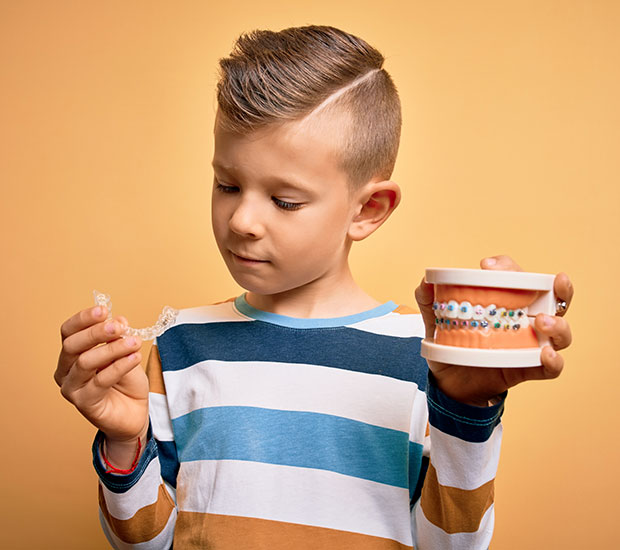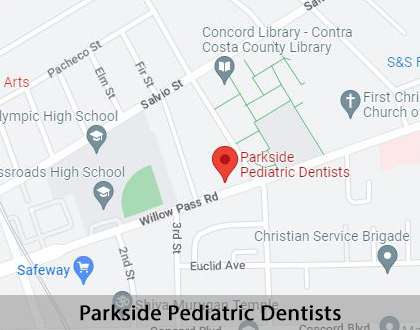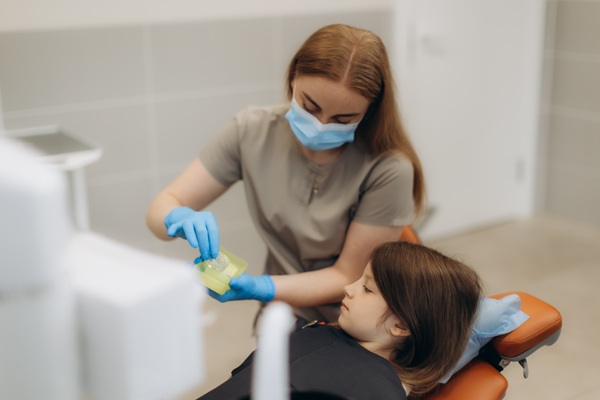Alternative to Braces for Kids Concord, CA
Orthodontic treatment is no longer a rite of passage into the teen years. More and more children are receiving orthodontics. The American Association of Orthodontists recommends children get an orthodontic consultation by the time they are seven years old. Kids have several options for alternatives to braces — including clear aligners, which use a series of trays that have been molded to fit and move the teeth.
Childhood is an important time to establish orthodontic health. Alternatives to braces for kids are available at Parkside Pediatric Dentists in Concord and the surrounding area. Call us at (925) 504-4011 to schedule an appointment to discuss the various treatment options.
The Options
Kids have many alternatives to braces. Today’s options work better and are more comfortable than the orthodontic options of the past. It is important to consider durability, ease of care, and aesthetics.
Clear Aligners
Clear aligners are a popular alternative to braces for kids and can correct a variety of orthodontic problems. The dentist fits the child for a series of clear, removable trays that go over the teeth. Patients need to wear the clear aligner for at least 20 hours a day for optimal results. Each new aligner in the series slowly adjusts the teeth a bit more until the desired outcome is achieved. Options are available for younger children specifically designed to target their special orthodontic needs.
Retainers
In some cases, a simple retainer is enough to straighten teeth that are only slightly out of place. Retainers are a type of dental device that can be fixed or removable. Some transparent versions are available that fit over the entire top of the mouth. The pediatric dentist can use a retainer to achieve minimal tooth movement.
Headgear
Headgear is the most obvious form of orthodontic treatment and involves a strap worn around the head attached to a dental device on the teeth. It is typically used to correct extreme malocclusion and works by putting pressure on the upper teeth and jaw. Often it only needs to be worn a few hours a day, and most patients wear it while they sleep.
“Today’s options work better and are more comfortable than the orthodontic options of the past.”
The Right Orthodontic Treatment
Kids need orthodontics for several reasons — ranging from crooked and overcrowded teeth to a bad bite. Tooth and jaw problems can be caused by the loss of baby teeth too soon, accidents, or thumb sucking. The type of orthodontic treatment often depends on the severity of the child’s case and the family’s comfort level with the different options.
A pediatric dentist will suggest alternatives to braces for kids if there is:
- Minor crowding or spacing issues
- Insignificant bite alignment problems
- A shorter treatment time required
Clear aligners are a good choice for a child who can be trusted to take care of the aligner trays and wear them the recommended amount of time. They are much less obvious than braces, making them a good choice for patients who might be self-conscious about metal braces. Orthodontic office visits are also less frequent, which saves time. In general, clear aligners also take less time overall to complete treatment.
“The type of orthodontic treatment often depends on the severity of the child’s case and the family’s comfort level with the different options.”
When Braces Are Unavoidable
Sometimes traditional metal braces represent the only solution. In that case, there are a few more aesthetically pleasing alternatives to the braces of the past. One of these options may be a good alternative for a child who is hesitant to wear the standard metal version.
Lingual Braces
Lingual braces are attached to the back of the teeth, making them virtually invisible. They treat the same orthodontic issues as traditional braces and come with the same cleaning route and food limitation. The major benefit is cosmetic. A patient with lingual braces looks as if they have no braces at all.
Ceramic Braces
Ceramic braces are similar to metal braces and use the same bracket system. The difference is the brackets are made of clear or tooth-colored ceramic material. They are less visible than metal braces but are still durable. For patients who are not a good candidate for clear aligners but still want something less noticeable than metal braces, ceramic braces are a viable alternative.
“Sometimes traditional metal braces are the only solution.”
Check out what others are saying about our dental services on Yelp: Alternative to Braces for Kids in Concord, CA
Removing Aligners
Clear aligners can be removed for eating, drinking, brushing, and tooth cleaning. They can also be removed for special occasions and when playing sports or an instrument. Since aligners can be lost or misplaced when they come out of the mouth, it is important to have a case nearby to keep the trays safe.
Just remember, clear aligners must be worn for 20 to 22 hours a day to get results. If they are worn any less than that, then the patient may negatively affect their treatment. Since clear aligners are removable, children may be tempted to remove them if there is discomfort. Parents and caregivers should remind their children that the aligners cannot work unless they remain in place.
“Clear aligners can be removed for eating, drinking, and tooth cleaning.”
Questions Answered on This Page
Q. Why would my child need orthodontic treatment?
Q. What are some options when it comes to braces?
Q. When can clear aligners be removed?
Q. What does my child need to do to care for their aligners?
People Also Ask
Caring for Aligners
Clear aligners need to be cleaned twice a day. A good rule is to do it at the same time as brushing and flossing. Brush the trays with a soft toothbrush with no toothpaste and rinse them in warm water. They also should be rinsed every time they are removed to keep bacteria and saliva from sticking to the surface.
Along with going over other treatment options, the American Dental Association states that aligners must be removed when eating and drinking. Teeth need to be brushed before the aligners get put back in to keep food particles from sticking in the trays. When taken care of properly, clear aligners are less likely to cause cavities or other tooth damage. Clear aligners need to be worn for at least 20 hours a day to be effective. It may be helpful to use a timer to remind the child that their aligners need to be in place to work. Often it is beneficial to switch to a new set of aligners before bed so that they can do their work overnight without any interruptions. Parents and caregivers should explain to their child the importance of keeping the aligners in their mouth and how it will result in a healthier smile.
“Clear aligners need to be cleaned twice a day.”
Frequently Asked Questions
Q. Will my child have any dietary restrictions with clear aligners?
A. Unlike traditional braces, clear aligners do not require any dietary restrictions. Since clear aligners are completely removable, your child can keep eating all their favorite foods. However, it is important that they remember to brush their teeth before putting their aligners back on.
Q. Are clear aligners a good choice for children?
A. Clear aligners are a good choice for a child who can be trusted to take care of the aligner trays and wear them the recommended amount of time. Orthodontic office visits are also less frequent, which saves time. In general, clear aligners also take less time overall to complete treatment.
Q. When can clear aligners be removed?
A. Clear aligners can be removed for eating, drinking, and tooth cleaning. They can also be removed for special occasions and when playing sports or an instrument. Since aligners can be lost or misplaced when they come out of the mouth, it is important to have a case nearby to keep the trays safe. Just remember, clear aligners must be worn for 20 to 22 hours a day to bring forth results.
Q. What if my child has to have braces?
A. When braces cannot be avoided, our pediatric dentist will discuss the options with you and your child. Lingual braces attach to the back of the teeth instead of the front, making them virtually invisible. Ceramic braces are similar to metal braces and use the same bracket system. The difference is the brackets are made of clear or tooth-colored ceramic material.
Q. What if my child breaks or loses their clear aligners?
A. Call us immediately and we will get started on creating a replacement set as soon as possible. In the meantime, we may advise your child to wear the previous set of aligners or move onto the next step, depending on what stage they were at in their treatment.
Quality Pediatric Dental Services Can Transform Smiles
By visiting us as soon as possible, our team can help get your child the professional treatment they need.
Definition of Pediatric Dental Terminology
Learn More About Alternatives to Braces for Kids
Depending on your child’s orthodontic needs, you have many alternatives to braces for kids to consider. To learn more, call us at 925-504-4011 to speak to our pediatric dentist about the available options.
If you live in the Concord area, call 925-504-4011 for an appointment in our Concord office.
Helpful Related Links
- American Dental Association (ADA). Glossary of Dental Terms. 2021
About our business, license, and website security
- Parkside Pediatric Dentists was established in 2022.
- We accept the following payment methods: American Express, Cash, Check, Discover, MasterCard, and Visa
- We serve patients from the following counties: Contra Costa County
- We serve patients from the following cities: Concord, Martinez, Pleasant Hill, Bay Point, Walnut Creek, and Antioch
- CA (License #63379). View License Information and Specifics
- National Provider Identifier Database (1255749644). View NPI Registry Information
- Norton Safe Web. View Details
- Trend Micro Site Safety Center. View Details







